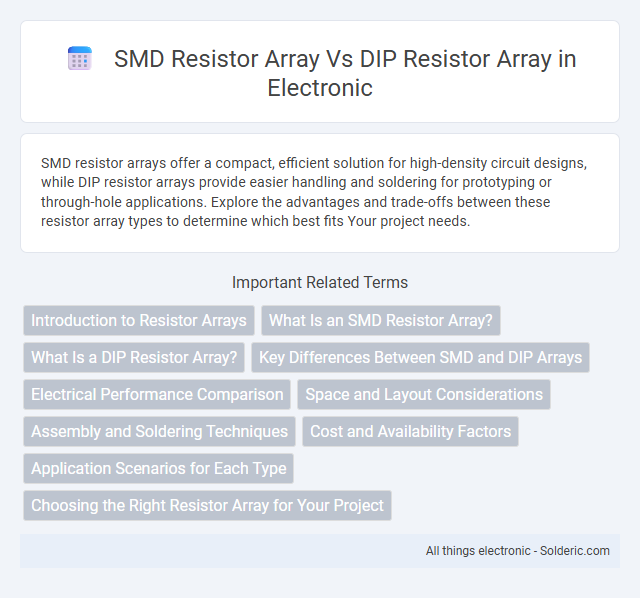SMD resistor arrays offer a compact, efficient solution for high-density circuit designs, while DIP resistor arrays provide easier handling and soldering for prototyping or through-hole applications. Explore the advantages and trade-offs between these resistor array types to determine which best fits Your project needs.
Comparison Table
| Feature | SMD Resistor Array | DIP Resistor Array |
|---|---|---|
| Package Type | Surface-Mount Device (SMD) | Dual In-line Package (DIP) |
| Mounting | Surface mount on PCB pads | Through-hole mounting |
| Size | Compact, smaller footprint | Larger, bulkier footprint |
| Assembly | Suitable for automated SMT assembly | Manual or automated through-hole assembly |
| Performance | Lower parasitic inductance and capacitance | Higher parasitic effects due to leads |
| Availability | Widely available in various resistance values and configurations | Common but less versatile than SMD arrays |
| Durability | Less mechanical stress but sensitive to handling | More robust due to leaded design |
| Cost | Generally lower cost in mass production | Higher assembly cost due to manual processes |
Introduction to Resistor Arrays
SMD resistor arrays offer compact, surface-mount packaging ideal for high-density circuit designs, while DIP resistor arrays feature through-hole mounting suited for prototyping and easy manual insertion. Each type contains several resistors within a single package, simplifying circuit layouts and saving board space. Your choice between SMD and DIP resistor arrays depends on factors like assembly method, space constraints, and application requirements.
What Is an SMD Resistor Array?
An SMD resistor array consists of multiple resistors packaged together in a single surface-mount device (SMD) component, enabling compact and efficient circuit design. Unlike DIP resistor arrays, which are designed for through-hole mounting, SMD resistor arrays offer lower profile and ease of automated assembly on printed circuit boards (PCBs). You can improve your electronics' reliability and reduce space requirements by choosing an SMD resistor array for high-density applications.
What Is a DIP Resistor Array?
A DIP resistor array is a compact package containing multiple resistors in a single Dual In-line Package (DIP), designed for through-hole mounting on printed circuit boards (PCBs). It simplifies circuit design by integrating several resistors with a common pin configuration, reducing board space and assembly time compared to using individual resistors. Unlike SMD resistor arrays, which are surface-mounted, DIP resistor arrays are preferred for prototyping or applications requiring easy manual insertion and replacement.
Key Differences Between SMD and DIP Arrays
SMD resistor arrays are surface-mounted components that offer a compact design, higher component density, and better suitability for automated assembly compared to DIP resistor arrays, which are through-hole components with pins designed for manual insertion. The thermal performance and electrical characteristics of SMD arrays typically benefit from shorter lead lengths, resulting in lower parasitic inductance and resistance, whereas DIP arrays provide easier prototyping and replacement due to their larger form factor. Your choice between SMD and DIP resistor arrays will depend on factors such as space constraints, manufacturing processes, and circuit design requirements.
Electrical Performance Comparison
SMD resistor arrays exhibit lower parasitic inductance and capacitance compared to DIP resistor arrays, resulting in improved high-frequency performance and reduced signal distortion. Thermal resistance is generally lower in SMD arrays, enhancing heat dissipation and stability under varying loads. DIP resistor arrays offer easier manual handling but typically have higher parasitic elements that can negatively impact precision in sensitive electronic circuits.
Space and Layout Considerations
SMD resistor arrays offer a significantly smaller footprint compared to DIP resistor arrays, enabling higher component density on PCBs and more efficient use of limited space in compact electronic designs. The surface-mount technology of SMD arrays simplifies automated placement and soldering processes, improving manufacturing efficiency and reducing assembly costs. DIP resistor arrays require through-hole mounting, which consumes more board area and complicates layout due to the need for drill holes and routing around component leads.
Assembly and Soldering Techniques
SMD resistor arrays require precise placement using automated pick-and-place machines, followed by reflow soldering, which ensures consistent and reliable solder joints on compact PCBs. DIP resistor arrays are manually inserted through plated holes and soldered via wave or hand soldering, making them more suitable for prototyping or low-volume production. Your choice affects assembly speed and soldering quality, with SMD favored for high-density, automated processes and DIP preferred for easier manual handling.
Cost and Availability Factors
SMD resistor arrays generally offer lower manufacturing costs due to automated assembly compatibility and smaller package sizes, making them highly cost-effective for large-scale production. DIP resistor arrays, though easier to handle and replace in prototyping or repair scenarios, tend to be more expensive and less readily available in high-density configurations. Your choice may depend on balancing budget constraints with the availability of components suited to your project's scale and assembly process.
Application Scenarios for Each Type
SMD resistor arrays are ideal for compact, high-density circuit boards where space-saving and automated assembly are critical, such as in smartphones and wearable devices. DIP resistor arrays suit through-hole designs, prototyping, and applications requiring manual assembly or easy replacement, commonly found in industrial equipment and educational kits. Choosing your resistor array depends on the manufacturing process and space constraints of your project.
Choosing the Right Resistor Array for Your Project
Choosing the right resistor array for your project depends on factors like space constraints, mounting method, and electrical requirements. SMD resistor arrays offer compact size and compatibility with automated assembly, ideal for high-density PCBs, while DIP resistor arrays provide easier manual handling and prototyping flexibility. Your decision should balance the benefits of miniaturization with ease of installation and circuit design needs.
SMD resistor array vs DIP resistor array Infographic

 solderic.com
solderic.com